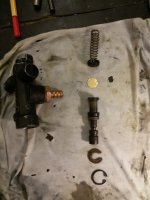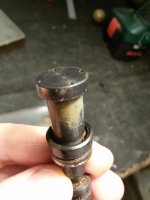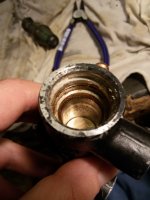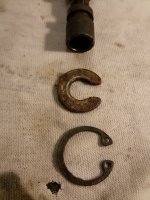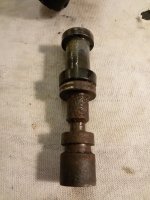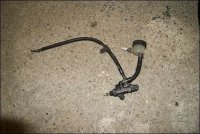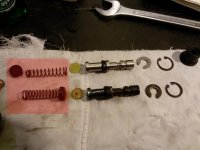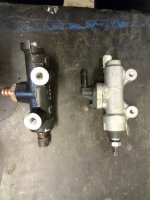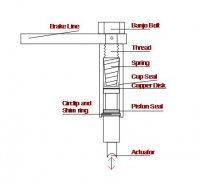You probably want to stick with the same size bore for a replacement master. The consequences are straight forward of changing parts. To move the piston in the caliper any given distance, a specific volume of fluid is required. That volume is provided by the master. Using a smaller bore master will require a larger travel of the master's piston to produce that same volume. The functional consequence will be that the effort required to produce a given force at the caliper will be less at the master with a smaller piston. So your brake will feel more powerful needing less pedal pressure for the same braking force. More pedal travel will be needed too, and while sometimes this is not especially noticeable, it potentially can be unworkable. You RD rear disc brake is way more than is needed already, so you probably don't want to make it any more sensitive.
Have to say your master looks like it should work. It is rough outside, but the inside looks ok. If you were holding your finger over the line connection and were getting high pressure, you should be able to continuously pump fluid out of the master as long as you let no air return to it. Once the line is connected, you should be able to fill it the same way, always preventing any air from being sucked into the line when the pedal is released. It helps to keep the caliper end high at all times, especially with a new line which for some reason are often harder to fill. Seeing the fluid move "up and down" is what you would expect to see. The master will not pump because it is easier to draw air back into the open line connection than it is to draw more fluid in from the reservoir. Realize that when the system is assembled and working, that the piston(s) in the caliper move only a tiny distance. The do not slide back and forth against their seals. The caliper piston(s) only gradually slide past their seals as the brake lining wears down, otherwise there is no movement at all between the seal and the piston. It is in fact very difficult to slide the piston along the seal, so in effect, it only can move forward as the hydraulic pressure forces it to. It is too hard to retract when the pressure is released, so fluid from the reservoir gets sucked in to the master instead to replace the lost volume. Once the pads come into contact with the disc, the pistons can move no further, and motion past the seals stops. When hydraulic pressure is applied, the piston travels forward a tiny distance, but not far enough to move past the grip of the seal, so the seal simply deforms. It grips the piston very tightly on one side, and is captured in a groove in the caliper on the other, and it just bends to accommodate the small displacement of the piston. When the pressure is released, the seal returns to its un-deformed state and the piston retracts slightly, just enough to release the grip on the disc. So most of the time, there is no "pumping" of fluid through the system. It is just the same fluid going back and forth. As the pads wear, eventually the piston(s) must travel far enough to move past the seal a bit, and when they do, they do not slide back all the way and a bit of fluid is drawn from the reservoir to make up the missing volume.
What this means is that when you are filling the system, you have to realize that simply "priming" the master will not make it start "pumping". The system must be sealed after the master's piston is compressed and before it is released in order for fluid to be drawn from the reservoir.
Since you have it apart, clean it carefully, and reassemble it with clean brake fluid only. Pay close attention to those four tiny holes in the end of the piston. They work with that thin disc and the spring to effect the one-way valve action, and might have been a source of difficulty for you if gummed up.


